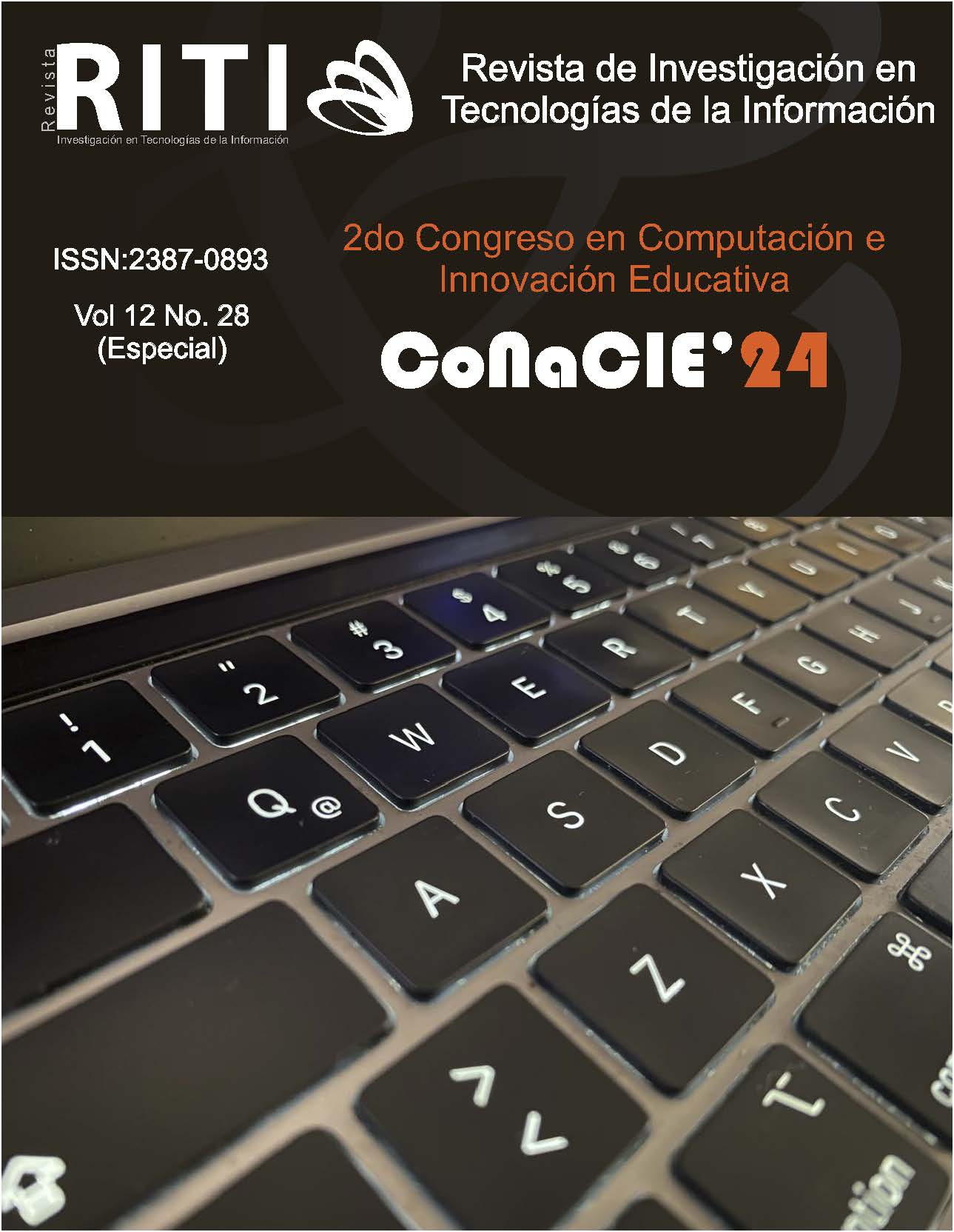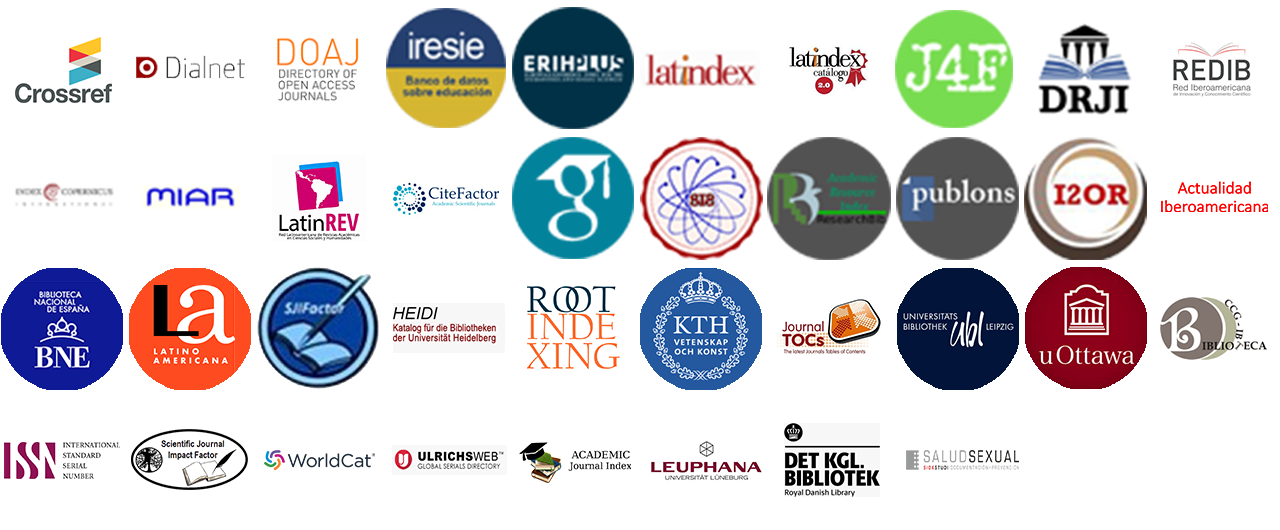Application of multicriteria assessment to evaluate climatic and environmental factors in the identification of arid regions in northwestern Mexico
DOI:
https://doi.org/10.36825/RITI.12.28.006Keywords:
Multicriteria Evaluation, Aridity, Analytical Hierarchy, Fuzzy Logic, GISAbstract
In Mexico, arid regions cover more than half of the territory, with desertification, degradation and droughts being the main problems in these ecosystems, caused mainly by climatic events and anthropogenic activities. The objective of this research was to apply multicriteria assessment (MCE) techniques to model factors that favor the increase in aridity, and to be able to identify areas with different levels of aridity in the Northwest region of Mexico by 2023. The Analytical Hierarchy Method (AHP) and Weighted Linear Summation (WLC) were used in a Geographic Information Systems (GIS) environment. The modeling was carried out with satellite images, which were: Temperature, Soil Moisture, Precipitation, Slopes, Normalized Differential Vegetation Index (NDVI), Digital Elevation Model (DEM), Vegetation Cover and Evapotranspiration. The results show that thanks to the effective integration of the factors with the EMC technique, regions with different levels of aridity could be identified; the northern and northwestern regions have a greater arid surface area with 41%, while the semi-arid regions, located in the west, represent 30% of the surface area, while the sub-humid regions were located in the southeast with 27% of the surface area.
References
Dunkerley, D. (2020). The Ecohydrology of Desert Environments: What Makes it Distinctive? En M. I. Goldstein, D. A. DellaSala (Eds.), Encyclopedia of the World’s Biomes (pp. 23–35). Elsevier. https://doi.org/10.1016/B978-0-12-409548-9.11803-2
ONU. (2010). ¿Qué son las zonas secas? http://www.fao.org/dryland-forestry/background/what-are-drylands/es/
Quichimbo, E. A., Singer, M. B., Cuthbert, M. O. (2020). Characterising groundwater–surface water interactions in idealised ephemeral stream systems. Hydrological Processes, 34 (18), 3792–3806. https://doi.org/10.1002/hyp.13847
Sánchez-Cano, J. E. (2019). Desarrollo sostenible de zonas áridas y semiáridas frente al cambio climático (1era Ed.). Universidad Juárez del Estado de Durango. https://play.google.com/books/reader?id=m36kDwAAQBAJ&pg=GBS.PP1&hl=es
FAO. (2007). Secuestro de carbono en tierras áridas. http://www.fao.org/3/Y5738s/Y5738s.pdf
Granados-Sánchez, D., Hernández-García, M. Á., Vázquez-Alarcón, A., Ruíz-Puga, P. (2013). Los procesos de desertificación y las regiones áridas. Revista Chapingo Serie Ciencias Forestales y del Ambiente, 19 (1), 45–66. https://doi.org/10.5154/r.rchscfa.2011.10.077
Mercado Μancera, G., Troyo Diéguez, E., Aguirre Gómez, A., Murillo Amador, B., Beltrán Morales, L., García Hernández, J. (2010). Calibración y aplicación del índice de aridez de De Martonne para el análisis del déficit hídrico como estimador de la aridez y desertificación en zona áridas. Universidad y Ciencia, 26 (1), 51–64. http://www.redalyc.org/articulo.oa?id=15416251004
Tabari, H., Hosseinzadeh Talaee, P., Mousavi Nadoushani, S. S., Willems, P., Marchetto, A. (2014). A survey of temperature and precipitation based aridity indices in Iran. Quaternary International, 345, 158–166. https://doi.org/10.1016/j.quaint.2014.03.061
Spinoni, J., Vogt, J., Naumann, G., Carrao, H., Barbosa, P. (2015). Towards identifying areas at climatological risk of desertification using the Köppen–Geiger classification and FAO aridity index. International Journal of Climatology, 35 (9), 2210–2222, https://doi.org/10.1002/joc.4124
Campos-Aranda, D. F. (2016). Estudio de sequías meteorológicas anuales por medio del índice de aridez, en el estado de Zacatecas, México. Ingeniería, investigación y tecnología, 17 (3), 405–417.
Li, Y., Feng, A., Liu, W., Ma, X., Dong, G. (2017). Variation of Aridity Index and the Role of Climate Variables in the Southwest China. Water, 9 (10), 1-14. https://doi.org/10.3390/w9100743
Zomer, R. J., Xu, J., Trabucco, A. (2022). Version 3 of the Global Aridity Index and Potential Evapotranspiration Database. Scientific Data, 9 (1), 1-15. https://doi.org/10.1038/s41597-022-01493-1
Díaz-Padilla, G., Sánchez-Cohen, I., Guajardo-Panes, R. A., Del Ángel-Pérez, A. L., Ruíz-Corral, A., Medina-García, G., Ibarra-Castillo, D. (2011). Mapeo del índice de aridez y su distribución poblacional en México. Revista Chapingo Serie Ciencias Forestales y del Ambiente, 17 (Especial), 267–275. https://www.scielo.org.mx/pdf/rcscfa/v17nspe/v17nspea24.pdf
Romero Dávila, J. T., Romero Dávila, Y. G., Cartuche Paqui, D. V. (2018). Evaluación multicriterio de los recursos turísticos en la Parroquia Uzhcurrumi, Canton Pasaje, Provincia de El Oro. Revista interamericana de ambiente y turismo (RIAT), 14 (2), 102–113. https://riat.utalca.cl/index.php/test/article/view/463
Holguín Castaño, V., Ortíz Grisalez, S., Velasco Navia, A., Mora Delgado, J. R. (2015). Evaluación multicriterio de 44 introducciones de Tithonia diversifolia (hemsl.) Gray en Candelaria, Valle del Cauca. Revista de la Facultad de Medicina Veterinaria y de Zootecnia, 62 (2), 57–72. https://doi.org/10.15446/rfmvz.v62n2.51995
Palacios Orejuela, G. B. (2018). Evaluación Multicriterio para la ubicación de un relleno sanitario en la Ciudad de Macas, a través de la ponderación de sus variables con el Proceso Analítico Jerárquico, AHP. Revista de Ciencias de Seguridad y Defensa, 3 (3), 60-71. https://journal.espe.edu.ec/ojs/index.php/revista-seguridad-defensa/article/view/RCSDV3N2ART04
Vanegas, J. G., Restrepo, J. A., Arango, A. I., Henao, A. C., Ortiz Mazo, E. (2017). Evaluación multicriterio e inventario de atractivos turísticos: Estudio de caso. Revista Espacios, 38 (23), 1-6. https://www.revistaespacios.com/a17v38n23/a17v38n23p25.pdf
Ahmed, A., Ranasinghe-Arachchilage, C., Alrajhi, A., Hewa, G. (2021). Comparison of Multicriteria Decision-Making Techniques for Groundwater Recharge Potential Zonation: Case Study of the Willochra Basin, South Australia. Water, 13 (4), 1-26. https://doi.org/10.3390/w13040525
Gómez Delgado, M., Barredo Cano, J. I. (2005). Sistemas de información geográfica y evaluación multicriterio en la ordenación del territorio (2da. Ed.). Ra-ma.
Hernández-Zaragoza, P., Valdez-Lazalde, J. R., Aldrete, A., Martínez-Trinidad, T. (2019). Evaluación multicriterio y multiobjetivo para optimizar la selección de áreas para establecer plantaciones forestales. Madera y bosques, 25 (2), 1-17. https://doi.org/10.21829/myb.2019.2521819
Monjardin-Armenta, S. A., Plata-Rocha, W., Pacheco-Angulo, C. E., Franco-Ochoa, C., Rangel-Peraza, J. G. (2020). Geospatial Simulation Model of Deforestation and Reforestation Using Multicriteria Evaluation. Sustainability, 12 (24), 1-20. https://doi.org/10.3390/su122410387
Perez-Aguilar, L. Y., Plata-Rocha, W., Monjardin-Armenta, S. A., Franco-Ochoa, C., Zambrano-Medina, Y. G. (2021). The Identification and Classification of Arid Zones through Multicriteria Evaluation and Geographic Information Systems—Case Study: Arid Regions of Northwest Mexico. ISPRS International Journal of Geo-Information, 10 (11), 1-17. https://doi.org/10.3390/ijgi10110720
Perez-Aguilar, L. Y., Plata-Rocha, W., Monjardin-Armenta, S. A., Franco-Ochoa, C. (2022). Aridity Analysis Using a Prospective Geospatial Simulation Model in This Mid-Century for the Northwest Region of Mexico. Sustainability, 14 (22), 1-22. https://doi.org/10.3390/su142215223
Akbari, M., Neamatollahi, E., Neamatollahi, P. (2019). Evaluating land suitability for spatial planning in arid regions of eastern Iran using fuzzy logic and multi-criteria analysis. Ecological Indicators, 98, 587–598. https://doi.org/10.1016/j.ecolind.2018.11.035
Saaty, T. (2008). Decision making with the analytic hierarchy process. International Journal of Services Sciences, 1 (1), 83-98. https://doi.org/10.1504/IJSSci.2008.01759
García Soldado, M. J., Chica Olmo, M. (2012). Comparación de los métodos de evaluación multicriterio AHP y OWA para el análisis de la vulnerabilidad de un acuífero detrítico. XV Congreso Nacional de Tecnologías de la Información Geográfica. Madrid, España.
Kurttila, M., Pesonen, M., Kangas, J., Kajanus, M. (2000). Utilizing the analytic hierarchy process (AHP) in SWOT analysis - A hybrid method and its application to a forest-certification case. Forest Policy and Economics, 1 (1), 41-52. https://doi.org/10.1016/S1389-9341(99)00004-0
Mallick, J., Singh, R. K., M., AlAwadh, M. A., Islam, S., Khan, R. A., Qureshi, M. N. (2018). GIS-based landslide susceptibility evaluation using fuzzy-AHP multi-criteria decision-making techniques in the Abha Watershed, Saudi Arabia. Environmental Earth Sciences, 77 (7), 1-25. https://doi.org/10.1007/s12665-018-7451-1
Gutiérrez-Ruacho, O. G., Brito-Castillo, L., Villarruel Sahagún, L., Troyo-Diéguez, E. (2012). Distribución espacial de la temperatura y precipitación y su relación con la vegetación del estado de Sonora. Revista Chapingo Serie Zonas Áridas, 11 (2), 106–111. https://www.redalyc.org/pdf/4555/Resumenes/Abstract_455545059007_2.pdf
UNEP. (1997). World Atlas of Desertification (2da Ed.). Oxford University Press.
CONAGUA. (2019). Índice Estandarizado de Precipitación (SPI). https://smn.cna.gob.mx/es/climatologia/monitor-de-sequia/spi
Cherlet, M., Hutchinson, C., Reynolds, J., Hill, J., Sommer, S., von Maltitz, G. (2018). World Atlas of Desertification (3rd Ed.). Office of the European Union. https://dx.doi.org/10.2760/06292
INEGI. (2021). Instituto Nacional de Estadística y Geografía. https://www.inegi.org.mx/
CONAGUA. (2012). Programa Hídrico Regional Visión 2030. Región Hidrológico-Administrativa I Península de Baja California. https://www.conagua.gob.mx/conagua07/publicaciones/publicaciones/1-sgp-17-12pbc.pdf
CONAGUA. (2012). Programa Hídrico Regional Visión 2030. Región Hidrológico-Administrativa II Noroeste. http://www.conagua.gob.mx/conagua07/publicaciones/publicaciones/2-sgp-17-12n.pdf
CONAGUA. (2012). Programa Hídrico Regional Visión 2030. Región Hidrológico-Administrativa III Pacífico Norte. https://www.conagua.gob.mx/conagua07/publicaciones/publicaciones/3-sgp-17-12pn.pdf
CGIAR-CSI. (2021). Global Aridity and PET Database. https://cgiarcsi.community/data/global-aridity-and-pet-database/
CONABIO. (2020). Portal de Información Geográfica. https://www.gob.mx/conabio
Nabati, J., Nezami, A., Neamatollahi, E., Akbari, M. (2020). GIS-based agro-ecological zoning for crop suitability using fuzzy inference system in semi-arid regions. Ecological Indicators, 117. https://doi.org/10.1016/j.ecolind.2020.106646
Ishizaka, A., Labib, A. (2011). Review of the main developments in the Analytic Hierarchy Process. Expert Systems with Applications, 38 (11), 14336-14345. https://doi.org/10.1016/j.eswa.2011.04.143
Saaty, T. L. (1997). A scaling method for priorities in hierarchical structures. Journal of Mathematical Psychology, 15 (3), 234–281. https://doi.org/10.1016/0022-2496(77)90033-5
Criado, M., Martínez-Graña, A., Santos-Francés, F., Veleda, S., Zazo, C. (2017). Multi-criteria analyses of urban planning for city expansion: A case study of Zamora, Spain. Sustainability, 9 (10), 1-18. https://doi.org/10.3390/su9101850
Diaz Salgado, J., López Blanco, J. (2000). Evaluación del potencial para acuacultura costera de camarón en el entorno de la laguna de Mar Muerto, mediante la aplicación de técnicas de análisis multicriterio con un SIG. Investigaciones geográficas, (41), 62-80. https://www.scielo.org.mx/pdf/igeo/n41/n41a5.pdf
Aydi, A. (2018). Evaluation of groundwater vulnerability to pollution using a GIS-based multi-criteria decision analysis. Groundwater for Sustainable Development, 7, 204–211. https://doi.org/10.1016/j.gsd.2018.06.003
Barrow, C. J. (1992). World atlas of desertification (United nations environment programme). Land Degradation & Development, 3 (4), 249–249. https://doi.org/10.1002/ldr.3400030407
Bonhomme, V., Castets, M., Morel, J., Gaucherel, C. (2015). Introducing the vectorial Kappa: An index to quantify congruence between vectorial mosaics. Ecological Indicators, 57, 96–99, https://doi.org/10.1016/j.ecolind.2015.04.007
Feizizadeh, B., Darabi, S., Blaschke, T., Lakes, T. (2022). QADI as a New Method and Alternative to Kappa for Accuracy Assessment of Remote Sensing-Based Image Classification. Sensors, 22 (12), 1-21. https://doi.org/10.3390/s22124506
Livadiotis, G., McComas, D. J. (2013). Understanding Kappa Distributions: A Toolbox for Space Science and Astrophysics. Space Science Reviews, 175 (1), 183–214. https://doi.org/10.1007/s11214-013-9982-9
Aldababseh, A., Temimi, M., Maghelal, P., Branch, O., Wulfmeyer, V. (2018). Multi-criteria evaluation of irrigated agriculture suitability to achieve food security in an arid environment. Sustainability, 10 (3), 1-33. https://doi.org/10.3390/su10030803
Charabi, Y., Gastli, A. (2011). PV site suitability analysis using GIS-based spatial fuzzy multi-criteria evaluation. Renewable Energy, 36 (9), 2554–2561. https://doi.org/10.1016/j.renene.2010.10.037
Ullah, K. M., Mansourian, A. (2016). Evaluation of Land Suitability for Urban Land-Use Planning: Case Study Dhaka City. Transactions in GIS, 20 (1), 20–37. https://doi.org/10.1111/tgis.12137
Downloads
Published
How to Cite
Issue
Section
License
Copyright (c) 2024 Revista de Investigación en Tecnologías de la Información

This work is licensed under a Creative Commons Attribution-NonCommercial 4.0 International License.
Esta revista proporciona un acceso abierto a su contenido, basado en el principio de que ofrecer al público un acceso libre a las investigaciones ayuda a un mayor intercambio global del conocimiento.
El texto publicado en la Revista de Investigación en Tecnologías de la Información (RITI) se distribuye bajo la licencia Creative Commons (CC BY-NC
 ), que permite a terceros utilizar lo publicado citando a los autores del trabajo y a RITI, pero sin hacer uso del material con propósitos comerciales.
), que permite a terceros utilizar lo publicado citando a los autores del trabajo y a RITI, pero sin hacer uso del material con propósitos comerciales.



